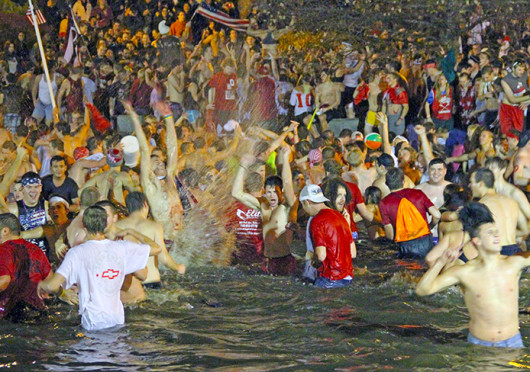
Ohio State fans jump in Mirror Lake as part of a Beat Michigan Week tradition in 2012. For this year’s jump, participants will be required to obtain a wristband in advance and file through a single entry point in order to reach the lake.
Credit: Daniel Chi / For The Lantern
Strapping wristbands on the arms of students and installing chain-link fences might be Ohio State’s way of increasing student safety on Mirror Lake jump night, but those same restrictions could also carry a hefty legal liability.
OSU officials announced Sunday there would be increased safety and security efforts for the Mirror Lake jump Tuesday night. There will be fences around the Mirror Lake area with one entrance spot and multiple exits, and students, whether jumping or watching, will be required to wear a wristband for admission to the area.
Jumping in Mirror Lake before the OSU football game against the University of Michigan is a university tradition. Tuesday’s weather forecast for the jump predicts a high of 34 degrees and a low of 27, with a 70 percent chance of snow, according to the Weather Channel.
A Cleveland-area lawyer said Monday the new measures could increase OSU’s liability if a student gets injured.
“It sounds like they’re increasing their liability by regulating it,” said the lawyer, who has worked in insurance defense and personal injury plaintiff practice throughout his career and requested anonymity because of the ongoing nature of the university regulations and the short notice on which those regulations were released. “Basically, at the time that they permit something to occur on their property and especially since they’re monitoring the people going in and out, they would have moral responsibility.”
The event has never been sanctioned by the university, something OSU Student Life Vice President Javaune Adams-Gaston said isn’t going to change.
“It’s not a university-sanctioned event,” she told The Lantern Sunday. “We really aren’t focused on the sanctioning versus the not sanctioning, it’s really about how can we help our students be safe as possible.”
The lawyer said, though, the liability issues don’t change even if the event is not officially sanctioned.
“(The event) could conceivably be argued to be sanctioned, and when you sanction something and let people into the area and there’s a potential for injury or danger, you acquire a duty,” he said. “When you sanction something, the expectation is that if you’re going to the trouble to sanction it, you’re going to the trouble to regulate it and if you’re going to the trouble to regulate it, you’re presumably trying to make it safe.”
The attorney also said, however, there are multiple exceptions under the law that could potentially exempt OSU from being found guilty if a lawsuit were to be filed, but he added a case would have to go through the court system for a decision to be made on whether OSU is subject to those exceptions.
A request for comment from OSU’s legal counsel was forwarded to OSU spokesman Gary Lewis, who said liability issues are not at the forefront of OSU officials’ reasoning for the new safety measures.
“The well-being of Ohio State students is our top priority, and for that reason, we will take appropriate efforts to maintain safety and security. Liability concerns, while important, are secondary to our efforts to promote the safety of our students,” Lewis said in a Monday email.
He did not provide additional comment about what liability concerns OSU would face if students were injured or in response to the attorney’s statement that the university’s liability could be increased.
Undergraduate Student Government President Taylor Stepp said Sunday he felt the new measures opened up the possibility for more problems than in the past.
“As a result of the precautions they’re taking, this could in fact create a more unsafe environment for the night,” said Stepp, a fourth-year in public affairs who said he’s jumped in the past and plans to jump Tuesday. “(The Mirror Lake jump night is) chaos. People are jumping into a freezing cold lake for goodness sake, but there have not been widespread injuries … We have the potential for more heinous injuries and more widespread injuries.”
Although Adams-Gaston said students were consulted during the process of deciding how to handle this year’s jump, many students have spoken out against the new measures. Additionally, some students created a Facebook event and Twitter page encouraging others to jump Monday night instead of Tuesday. More than 700 people had responded that they were going to attend as of 8:30 p.m. Monday, while more than 8,000 were invited.


